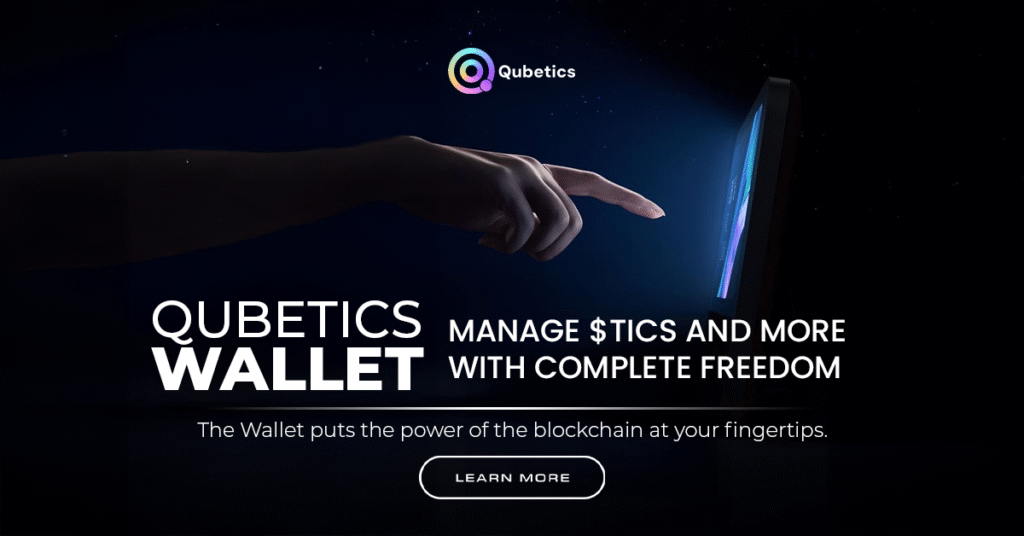
Didn’t Catch Near Protocol Below $1? Qubetics Is Gaining Fast as a Future Most Popular Cryptocurrency
What makes a crypto protocol stand out in today’s market? That’s the question everyone’s asking as the altcoin space continues to evolve beyond flashy tokens and hype-driven rallies. Utility, scalability, and real-world integration are becoming the new benchmarks for what the most popular cryptocurrency really looks like. NEAR Protocol, for example, has quietly built one of the most developer-friendly blockchains in the space. With its sharded infrastructure, low gas fees, and recent strides toward creating a universal Blockchain Operating System (BOS), $NEAR climbed from just $1.45 in late 2022 to over $7 in 2025—proving that adoption and infrastructure still rule over noise. But now, attention is shifting to a next-gen platform that’s moving fast, delivering tools, and locking in serious momentum—Qubetics ($TICS).
While $NEAR laid down critical architecture for Web3 applications, Qubetics is focused on unifying the blockchain experience altogether. Its Non-Custodial Multi-Chain Wallet and QubeQode IDE are tackling problems $NEAR and others haven’t fully addressed—like secure cross-chain access, seamless asset management, and no-code application development. And with the final stage of its crypto presale underway, Qubetics is drawing fresh eyes as a serious contender for the title of the most popular cryptocurrency rising in 2025.
Qubetics ($TICS): Infrastructure Designed for Scalable Real-World Utility
Qubetics enters this arena with a distinct proposition: it offers functional tools designed for adoption at both the enterprise and individual level. This is not simply another Layer-1 protocol. Qubetics integrates core infrastructure with practical accessibility—focusing on usability, interoperability, and deployment tools that support growth across sectors.
At the center of Qubetics’ infrastructure is its Non-Custodial Multi-Chain Wallet, which redefines how users manage assets across blockchain networks. Rather than requiring bridging mechanisms or manual network switching, the wallet allows seamless management of assets across multiple Layer-1 chains—including Bitcoin, Ethereum, and others—through a unified interface.
This tool has immediate relevance across industries and demographics. For example, a freelance worker managing global client payments in USDC and ETH can conduct all transactions within a single wallet without relying on custodial exchanges or bridge providers. A retail operation looking to integrate crypto payments without technical overhead can accept and manage multiple assets natively. Non-profit organizations disbursing aid across developing markets can execute stablecoin transfers with precision and transparency—without incurring unnecessary fees or delays.
The Qubetics wallet is central to the protocol’s ambition to become the most popular cryptocurrency by utility. It eliminates operational friction while maintaining decentralization, thereby aligning with market demands for usability and control.
Qubetics also delivers comprehensive development tools designed to support mass adoption and scalable innovation. QubeQode, the protocol’s low-code/no-code smart contract builder, enables users with minimal technical knowledge to deploy decentralized applications. This is particularly relevant for entrepreneurs, small business owners, and content creators seeking blockchain solutions without the cost of dedicated development teams.
For more advanced developers, the Qubetics IDE provides a secure, fully integrated environment for writing, testing, and deploying Web3 applications. Built for efficiency and performance, the IDE removes the need for external integrations, ensuring secure and streamlined workflows.
The combination of the Non-Custodial Multi-Chain Wallet, QubeQode, and Qubetics IDE reinforces the project’s utility-led architecture—establishing it as a viable candidate for the most popular cryptocurrency title in the upcoming cycle.
Qubetics is now in Stage 37 of its final public crypto presale. The fixed price of $0.3370 per token has attracted strong demand, with over 515 million tokens sold and more than $18 million raised from over 27,900 backers. The final 10 million tokens remain available before the protocol transitions to its listing stage at $0.40.
Projections based on current adoption metrics and protocol design indicate that if $TICS reaches $1 post-listing, it would represent a 3,112% return from the earliest presale pricing tiers. A climb to $5 would reflect a 15,964% increase, while a long-term target of $15—following full mainnet deployment and cross-industry integration—would deliver an exceptional 48,092% return on initial capital.
To illustrate this with a practical scenario: an $18,000 allocation at the current price of $0.3370 would secure approximately 53,414 $TICS. Should the token reach $1, the holding would be valued at $53,414. At $5, the portfolio’s worth would rise to $267,070. If $TICS achieves the $15 milestone, that same allocation would be valued at $801,210.
Further strengthening its economic model, Qubetics has recently restructured its tokenomics. Crypto sale allocation was increased to 38.55%, transferring greater ownership to the community and reinforcing decentralization. These changes were designed to enhance long-term sustainability while aligning with global trends toward user-led governance in blockchain ecosystems.
Near Protocol: Technologically Capable, but Commercially Constrained
Near Protocol ($NEAR) was launched to address key inefficiencies in early-generation blockchains, including speed, cost, and scalability. Its Nightshade sharding mechanism allowed Near to process transactions more efficiently, and its EVM-compatible Aurora layer opened the door for Ethereum developers to transition more easily. This architectural focus earned Near recognition as one of the more technically sound protocols in the Layer-1 category.
Despite these advancements, Near has struggled to capture dominant market share or drive mass user engagement. As of June 2025, the $NEAR token trades around $6.34. Analyst projections place its potential price range between $10 and $12 in the event of a broader market surge. While stable, this projected growth does not indicate breakout potential.
The platform’s user acquisition rate remains moderate, and its dApp ecosystem lacks widespread traction. There are few examples of large-scale commercial or cross-sector adoption. As a result, while Near maintains credibility among developers, it has not achieved recognition as the most popular cryptocurrency by usage or integration. In a market defined increasingly by practical deployment and measurable utility, its lack of front-facing applications places it at a competitive disadvantage.
Conclusion: A Utility-Led Framework Poised for Widespread Adoption
Near Protocol remains a respected name in Layer-1 development circles, with architectural features that reflect thoughtful engineering. However, in an environment where real-world usability defines growth, the most popular cryptocurrency must demonstrate seamless application and scalable integration.
Qubetics is positioned to deliver on both fronts. Through its Non-Custodial Multi-Chain Wallet, it provides practical tools for asset management and payments across networks. Through QubeQode and its native IDE, it empowers users at all skill levels to build, deploy, and operate efficiently in the decentralized economy.
With a rapidly closing crypto presale, a structured token supply, and analyst-backed projections that point to a significant valuation trajectory, Qubetics is no longer an emerging name—it is a leading candidate to define the next phase of digital asset adoption.
Those evaluating participation in this final stage are not merely speculating—they are positioning themselves at the foundation of what may become the most popular cryptocurrency of the next market cycle.
For More Information:
Qubetics: https://qubetics.com/
Presale: https://buy.qubetics.com/
Telegram: https://t.me/qubetics/
Twitter: https://x.com/qubetics/
Disclaimer: The content above is a sponsored article and does not represent the editorial opinion of aicryptocore.com.








